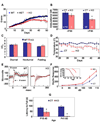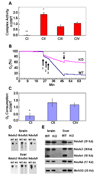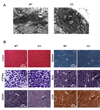Mice with mitochondrial complex I deficiency develop a fatal encephalomyopathy
- PMID: 18396137
- PMCID: PMC2593686
- DOI: 10.1016/j.cmet.2008.02.004
Mice with mitochondrial complex I deficiency develop a fatal encephalomyopathy
Abstract
To study effects of mitochondrial complex I (CI, NADH:ubiquinone oxidoreductase) deficiency, we inactivated the Ndufs4 gene, which encodes an 18 kDa subunit of the 45-protein CI complex. Although small, Ndufs4 knockout (KO) mice appeared healthy until approximately 5 weeks of age, when ataxic signs began, progressing to death at approximately 7 weeks. KO mice manifested encephalomyopathy including a retarded growth rate, lethargy, loss of motor skill, blindness, and elevated serum lactate. CI activity in submitochondrial particles from KO mice was undetectable by spectrophotometric assays. However, CI-driven oxygen consumption by intact tissue was about half that of controls. Native gel electrophoresis revealed reduced levels of intact CI. These data suggest that CI fails to assemble properly or is unstable without NDUFS4. KO muscle has normal morphology but low NADH dehydrogenase activity and subsarcolemmal aggregates of mitochondria. Nonetheless, total oxygen consumption and muscle ATP and phosphocreatine concentrations measured in vivo were within normal parameters.
Figures




Comment in
-
Complex I: a complex gateway to the powerhouse.Cell Metab. 2008 Apr;7(4):278-9. doi: 10.1016/j.cmet.2008.03.011. Cell Metab. 2008. PMID: 18396129
Similar articles
-
Mitochondrial complex III stabilizes complex I in the absence of NDUFS4 to provide partial activity.Hum Mol Genet. 2012 Jan 1;21(1):115-20. doi: 10.1093/hmg/ddr446. Epub 2011 Sep 28. Hum Mol Genet. 2012. PMID: 21965299
-
Metabolic consequences of NDUFS4 gene deletion in immortalized mouse embryonic fibroblasts.Biochim Biophys Acta. 2012 Oct;1817(10):1925-36. doi: 10.1016/j.bbabio.2012.03.006. Epub 2012 Mar 11. Biochim Biophys Acta. 2012. PMID: 22430089
-
Proteomic and metabolomic analyses of mitochondrial complex I-deficient mouse model generated by spontaneous B2 short interspersed nuclear element (SINE) insertion into NADH dehydrogenase (ubiquinone) Fe-S protein 4 (Ndufs4) gene.J Biol Chem. 2012 Jun 8;287(24):20652-63. doi: 10.1074/jbc.M111.327601. Epub 2012 Apr 25. J Biol Chem. 2012. PMID: 22535952 Free PMC article.
-
Cellular and animal models for mitochondrial complex I deficiency: a focus on the NDUFS4 subunit.IUBMB Life. 2013 Mar;65(3):202-8. doi: 10.1002/iub.1127. Epub 2013 Feb 3. IUBMB Life. 2013. PMID: 23378164 Review.
-
Mitochondrial complex I deficiency of nuclear origin I. Structural genes.Mol Genet Metab. 2012 Feb;105(2):163-72. doi: 10.1016/j.ymgme.2011.11.188. Epub 2011 Nov 18. Mol Genet Metab. 2012. PMID: 22142868 Review.
Cited by
-
NAD+ Regeneration Rescues Lifespan, but Not Ataxia, in a Mouse Model of Brain Mitochondrial Complex I Dysfunction.Cell Metab. 2020 Aug 4;32(2):301-308.e6. doi: 10.1016/j.cmet.2020.06.003. Epub 2020 Jun 22. Cell Metab. 2020. PMID: 32574562 Free PMC article.
-
Altered anesthetic sensitivity of mice lacking Ndufs4, a subunit of mitochondrial complex I.PLoS One. 2012;7(8):e42904. doi: 10.1371/journal.pone.0042904. Epub 2012 Aug 17. PLoS One. 2012. PMID: 22912761 Free PMC article.
-
Myopathy reversion in mice after restauration of mitochondrial complex I.EMBO Mol Med. 2020 Feb 7;12(2):e10674. doi: 10.15252/emmm.201910674. Epub 2020 Jan 9. EMBO Mol Med. 2020. PMID: 31916679 Free PMC article.
-
Noninvasive Ophthalmic Imaging Measures Retinal Degeneration and Vision Deficits in Ndufs4-/- Mouse Model of Mitochondrial Complex I Deficiency.Transl Vis Sci Technol. 2022 Aug 1;11(8):5. doi: 10.1167/tvst.11.8.5. Transl Vis Sci Technol. 2022. PMID: 35921115 Free PMC article.
-
On the dynamic and even reversible nature of Leigh syndrome: Lessons from human imaging and mouse models.Curr Opin Neurobiol. 2022 Feb;72:80-90. doi: 10.1016/j.conb.2021.09.006. Epub 2021 Oct 14. Curr Opin Neurobiol. 2022. PMID: 34656053 Free PMC article. Review.
References
-
- Abid MR, Schoots IG, Spokes KC, Wu SQ, Mawhinney C, Aird WC. Vascular endothelial growth factor-mediated induction of manganese superoxide dismutase occurs through redox-dependent regulation of forkhead and IkappaB/NF-kappaB. J. Biol. Chem. 2004;279:44030–44038. - PubMed
-
- Benit P, Steffann J, Lebon S, Chretien D, Kadhom N, de Lonlay P, Goldenberg A, Dumez Y, Dommergues M, Rustin P, et al. Genotyping microsatellite DNA markers at putative disease loci in inbred/multiplex families with respiratory chain complex I deficiency allows rapid identification of a novel nonsense mutation (IVS1nt -1) in the NDUFS4 gene in Leigh syndrome. Hum. Genet. 2003;112:563–566. - PubMed
-
- Boulant JA. Role of the preoptic-anterior hypothalamus in thermoregulation and fever. Clin. Infect. Dis. 2000;31:S157–S161. - PubMed
-
- Budde SM, van den Heuvel LP, Janssen AJ, Smeets RJ, Buskens CA, DeMeirleir L, Van Coster R, Baethmann M, Voit T, Trijbels JM, Smeitink JA. Combined enzymatic complex I and III deficiency associated with mutations in the nuclear encoded NDUFS4 gene. Biochem. Biophys. Res. Commun. 2000;18:63–68. - PubMed
Publication types
MeSH terms
Substances
Grants and funding
LinkOut - more resources
Full Text Sources
Other Literature Sources
Molecular Biology Databases
Research Materials

